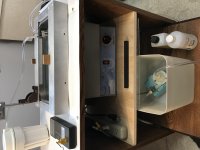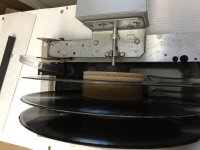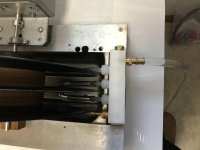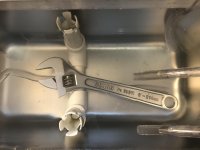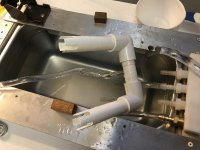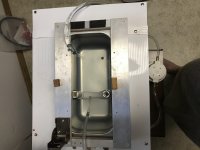What kind of pump are you using, Andy?
B B
This one, B B:
Amazon.com: Uniclife 10L/min DC 12V Brushless Water Pump Submersible oil pump 16ft 20W: Pet Supplies
Andy
OK, Andy, I have one of those same pumps that I've played around with (but I don't use it in my record cleaning). This isn't a real robust pump, but decent given the low price. I definitely wouldn't run this pump full time / continuously. Temp limit is listed at 122° F, which is not real high, so you do have to be mindful of its temperature. I'd run it no more than about 7-8 minutes at a time, then let it sit for the same before using again.
B B
B B
OK, Andy, I have one of those same pumps that I've played around with (but I don't use it in my record cleaning). This isn't a real robust pump, but decent given the low price. I definitely wouldn't run this pump full time / continuously. Temp limit is listed at 122° F, which is not real high, so you do have to be mindful of its temperature. I'd run it no more than about 7-8 minutes at a time, then let it sit for the same before using again.
B B
Great - thanks for the comment, BB.
Will do - so I'll change my cleaning regime so I:
* degass with the pump running.
* turn off pump and do a clean cycle.
* then turn on pump whilst changing LPs.
Regards,
Andy
Hello all. I recently got back to cleaning my vinyl after a long break. I have a problem with floating particles clinging to the lps when I lift them out of the bath. Sonix IV 60khz/distilled water with 1/4c 91% ISO and 4 drops photoflow per gallon/ ~98 degrees F./ 1 micron filter with plenty of recirculation. I made a skimmer for the outflow, so I’m removing the bath water near the surface. After one revolution, I turn off the US and only run the pump for one more half-revolution. I turn the spindle backwards a bit and jiggle it before lifting out. Could this simply be static that builds up in the records?? Anyone experimented with grounding the records as they are cleaned?
Hi Groove,
I've been contemplating a skimmer. I'd love to see pics of your implementation.
I don't believe it's a static issue, but rather just contact as the records are pulled out of the bath. What does your return tube from your pump/filter look like? Could you use outflow back into the tank as a rinse mechanism to take the floaters off the LPs?
Cheers,
B B
I've been contemplating a skimmer. I'd love to see pics of your implementation.
I don't believe it's a static issue, but rather just contact as the records are pulled out of the bath. What does your return tube from your pump/filter look like? Could you use outflow back into the tank as a rinse mechanism to take the floaters off the LPs?
Cheers,
B B
Here are some pics. I put everything together on an old printer stand. The pump is a Little Giant 2E-38n 1/40hp. It has to be run in a bucket of water because it gets warm. Actually nice, because the water heats up and that helps maintain bath temp and I can leave the heater off. The skimmer is made from PVC. The stainless plug in the top has a 3/8 hole. The tubing end is near the bottom inside the skimmer. The supply tube goes to the bottom of the tank aimed away from the skimmer.Hi Groove,
I've been contemplating a skimmer. I'd love to see pics of your implementation.
I don't believe it's a static issue, but rather just contact as the records are pulled out of the bath. What does your return tube from your pump/filter look like? Could you use outflow back into the tank as a rinse mechanism to take the floaters off the LPs?
Cheers,
B B
I think I might split the supply tube into 4 tubes to create a flow between and outside the (3) records, aimed toward the skimmer
Attachments
Thanks for the pics, Groove. So, I take it the skimmer is not capturing enough of the floaters? Questions:
1) Are any floaters actually sucked into your intake and deposited in your canister filter?
2) Do any typically remain in the small well created by the slotted PVC intake?
3) Or do most of the floaters remain scattered in the overall tank?
I assume you've got mostly #3 as your situation, since you mentioned trying to get flow going from water inflow toward the skimmer.
(I really like your implementation of my Version 2 frame, hinge and arm!)
Best,
B B
1) Are any floaters actually sucked into your intake and deposited in your canister filter?
2) Do any typically remain in the small well created by the slotted PVC intake?
3) Or do most of the floaters remain scattered in the overall tank?
I assume you've got mostly #3 as your situation, since you mentioned trying to get flow going from water inflow toward the skimmer.
(I really like your implementation of my Version 2 frame, hinge and arm!)
Best,
B B
1) yes, but they have to be pretty close to it to go in. Maybe the slots are too long, which is pulling more water in from below the surface. I think my original thought was to pull out non floaters as well. When I do a filter change, it is pretty dirty.Thanks for the pics, Groove. So, I take it the skimmer is not capturing enough of the floaters? Questions:
1) Are any floaters actually sucked into your intake and deposited in your canister filter?
2) Do any typically remain in the small well created by the slotted PVC intake?
3) Or do most of the floaters remain scattered in the overall tank?
I assume you've got mostly #3 as your situation, since you mentioned trying to get flow going from water inflow toward the skimmer.
(I really like your implementation of my Version 2 frame, hinge and arm!)
Best,
B B
2) I don’t think so.
3) yes. They are easy to see with a bright led flashlight. They generally move less between the records, and in all directions.
The pump may not be strong enough for the filter, or the plastic barbed fittings
I’m using have too small of an I.D.. I can change to metal fittings and drill them out. I can also wrap some tape around the lower half of the skimmer.
I have gone to the next larger size tubing, 3/8” inside diameter. The larger barb fittings have larger through holes, and I am now getting about 1.2 gallons per minute flow. I repositioned the skimmer and made a manifold to flow water on all sides of the records, toward the skimmer, but am having no luck getting particles to move toward the skimmer uniformly. After running a load for awhile, I see a lot of particles “hanging around” on the near side of the closest record, with diminishing # of particles in spaces between records (going closer to the skimmer), and almost no particles in the last space, where the skimmer is.
I seem to have better results with just one supply tube aimed at the bottom of the tank.
One problem I am now having with the increased flow is, if the skimmer slots are just a bit above the bath surface, I suck air. When below the surface, there is a small whirlpool near the skimmer, so I am going to make a longer skimmer with shorter, wider slots near the top.
I seem to have better results with just one supply tube aimed at the bottom of the tank.
One problem I am now having with the increased flow is, if the skimmer slots are just a bit above the bath surface, I suck air. When below the surface, there is a small whirlpool near the skimmer, so I am going to make a longer skimmer with shorter, wider slots near the top.
Attachments
Skimmer
I made some good progress today on making a better (dual) skimmer. See photos. I’m at the point where, with only the pump running and no U.S., and no records, I get a strong movement of surface particles toward the skimmers and they get removed. One problem is that the bath level is pretty critical. If too low, air gets sucked through. This could be controlled during cleaning by an in-line valve, rather than adjusting the bath level. As we all probably know, bath level goes down during cleaning due to evaporation and records wet during removal.
One thing I wonder about is, does adding things like this in the bath affect cleaning action?
In one photo, you can kinda see the “waterfalls “ in the skimmers
I made some good progress today on making a better (dual) skimmer. See photos. I’m at the point where, with only the pump running and no U.S., and no records, I get a strong movement of surface particles toward the skimmers and they get removed. One problem is that the bath level is pretty critical. If too low, air gets sucked through. This could be controlled during cleaning by an in-line valve, rather than adjusting the bath level. As we all probably know, bath level goes down during cleaning due to evaporation and records wet during removal.
One thing I wonder about is, does adding things like this in the bath affect cleaning action?
In one photo, you can kinda see the “waterfalls “ in the skimmers
Attachments
Last edited:
Floaters
I imagine that most of us just rinse the record off to remove these large particles. I have also found that a bit more photoflo also helps.
You have a very nice setup I must say!
It has been a long time since I posted, when I mostly asked basic set up questions. I should report that I have been using a cheap Chinese 10 liter tank (the ubiquitous eBay 40A, 40 Hz) with great success. I do a prewash in warm tap water and a drop of dish soap with a quick swipe with the grooves with a wide microfiber painting brush. Taken together, the process does a great job on dirty LPs from thrift shops.
I imagine that most of us just rinse the record off to remove these large particles. I have also found that a bit more photoflo also helps.
You have a very nice setup I must say!
It has been a long time since I posted, when I mostly asked basic set up questions. I should report that I have been using a cheap Chinese 10 liter tank (the ubiquitous eBay 40A, 40 Hz) with great success. I do a prewash in warm tap water and a drop of dish soap with a quick swipe with the grooves with a wide microfiber painting brush. Taken together, the process does a great job on dirty LPs from thrift shops.
Skimmer update
Today, I basically rebuilt the dual skimmer, using thicker walled pvc pipe. I spent a lot of time trying to figure out how to secure it so it doesn’t move around. I ended up cutting the sides and bottoms of the 90 degree fittings so they would sit flat on the bottom of the tank, and get as close to the sides of the tank as possible. I ended up using thick double sided tape to stick it to the tank bottom.
Results- after cleaning several loads, I am happy! The skimmers are removing LOTS of floaters, and I don’t see them attached to the records any more. I am not using the four supply tubes, just one, aimed at the bottom of the tank.
Today, I basically rebuilt the dual skimmer, using thicker walled pvc pipe. I spent a lot of time trying to figure out how to secure it so it doesn’t move around. I ended up cutting the sides and bottoms of the 90 degree fittings so they would sit flat on the bottom of the tank, and get as close to the sides of the tank as possible. I ended up using thick double sided tape to stick it to the tank bottom.
Results- after cleaning several loads, I am happy! The skimmers are removing LOTS of floaters, and I don’t see them attached to the records any more. I am not using the four supply tubes, just one, aimed at the bottom of the tank.
Attachments
I ended up using thick double sided tape to stick it to the tank bottom.
Groove,
Can't you hang the pvc from the top of the tank instead of taping it to the bottom? I wouldn't want double sided tape in my cleaning tank. I suspect the adhesive and the tape will break down over time from the vibration of the tank bottom, the cavitation action, and the solvent bath. You're also probably diminishing the cleaning action of the ultrasonics by dampening the tank bottom, which transmits all of the ultrasonic energy from the transducers into the tank bath.
Cheers,
B B
Excellent point! I will make that change todayGroove,
Can't you hang the pvc from the top of the tank instead of taping it to the bottom?
Cheers,
B B
Grainger Industrial Supply
I thought I would post this to aid those who are building units.
To those who struggle to find hardware to build their US cleaners, I highly recommend Grainger. Although they are an industrial supplier, they take retail orders at the same prices as wholesale. On line ordering, with free delivery/no handing charge to their distribution points which are ubiquitous in the US. Any midsize city seems to have several locations. For most items the delivery is overnight. English measure, metric measure items, rods, bearings, couplers, etc. they have it all. And their prices are low. It is much easier to use them than venturing to Home Depot/Lowes and endding up scrounging for substitutes for what one really wants.
I thought I would post this to aid those who are building units.
To those who struggle to find hardware to build their US cleaners, I highly recommend Grainger. Although they are an industrial supplier, they take retail orders at the same prices as wholesale. On line ordering, with free delivery/no handing charge to their distribution points which are ubiquitous in the US. Any midsize city seems to have several locations. For most items the delivery is overnight. English measure, metric measure items, rods, bearings, couplers, etc. they have it all. And their prices are low. It is much easier to use them than venturing to Home Depot/Lowes and endding up scrounging for substitutes for what one really wants.
Today, I basically rebuilt the dual skimmer, using thicker walled pvc pipe. I spent a lot of time trying to figure out how to secure it so it doesn’t move around. I ended up cutting the sides and bottoms of the 90 degree fittings so they would sit flat on the bottom of the tank, and get as close to the sides of the tank as possible. I ended up using thick double sided tape to stick it to the tank bottom.
Results- after cleaning several loads, I am happy! The skimmers are removing LOTS of floaters, and I don’t see them attached to the records any more. I am not using the four supply tubes, just one, aimed at the bottom of the tank.
InDaGroove:
I agree with bbftx- Eventually, the double sided tape will break down and contaminate the water and your records! Especially when using the more powerful 40Khz frequency.
I have also stated before that water circulation during cavitation (while the ultrasonics are running) will diminish the cleaning action, not only by reintroducing dissolved air back into the water, but through the movement of the water. Cavitation will be reduced and affect cleaning results.
My suggestion/idea would be to devise a "clean rinse" after the cleaning cycle; lift the records out of the water, filtered water rinses the record as it turns, water and debris left on the record drips back into the tank, water pump/skimmer filters the water and debris out.
-Louis
InDaGroove:
I agree with bbftx- Eventually, the double sided tape will break down and contaminate the water and your records! Especially when using the more powerful 40Khz frequency.
I have also stated before that water circulation during cavitation (while the ultrasonics are running) will diminish the cleaning action, not only by reintroducing dissolved air back into the water, but through the movement of the water. Cavitation will be reduced and affect cleaning results.
My suggestion/idea would be to devise a "clean rinse" after the cleaning cycle; lift the records out of the water, filtered water rinses the record as it turns, water and debris left on the record drips back into the tank, water pump/skimmer filters the water and debris out.
-Louis
Thank you- I wholeheartedly agree. I did hang the skimmer as soon as bbftx suggested doing it. I am now going to do the cleaning cycle (1 revolution) with US on and pump off, then 1 rev with pump on and US off.
Dear all,
I've discovered some strange, dark spots on the bottom of the bowl, where the transducers are installed (on the other side). My machine is still in experimental phase (a year ago or more...) but has already several hours of operation. Some time ago I noticed only one slight spot (the one which is now the strongest one) and by accumulating more and more operation hours, now I've got these spots on all the transducer's fixing points. If you touch them it feels like a very fine sanding paper (like 1000 or more). I suppose it is a kind of erosion.
Anybody else experienced something like this?





I've discovered some strange, dark spots on the bottom of the bowl, where the transducers are installed (on the other side). My machine is still in experimental phase (a year ago or more...) but has already several hours of operation. Some time ago I noticed only one slight spot (the one which is now the strongest one) and by accumulating more and more operation hours, now I've got these spots on all the transducer's fixing points. If you touch them it feels like a very fine sanding paper (like 1000 or more). I suppose it is a kind of erosion.
Anybody else experienced something like this?
- Home
- Source & Line
- Analogue Source
- My version of an Ultrasonic Record Cleaner
